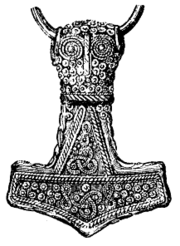Mjolnir
|
|
Vasara.jpg
In Norse mythology, Mjolnir (also Mjollnir, literally "that which smashes") is the Hammer of Thor, the god of lightning and thunder. This war hammer (made by the dwarves Sindri and Brokk) had enormous destructive capabilities, and was associated with lightning. When thrown, it would return to the thrower's hand after striking its target. Only Thor and his son, Magni, could lift it. The account of how Thor came by Mjolnir is given in the 11th century poem Thorsdrapa.
| Contents |
Culture
Replicas of the hammer were widely popular in Scandinavia and were used in Blóts and other sacral ceremonies, such as weddings. In 1925, in Gotland, a hammer was still put in the bed of the newlyweds to bring fertility to the new family. During the period of Christian missionary, it was a popular symbol competing with the Christian cross and sometimes even worn beside it.
Today, replicas of such hammers are frequently used and sold in jewelry shops and worn by many, especially by those interested in Norse mythology and ancient Scandinavian history, but also as a macho symbol.
Norse myth
With the hammer, Thor indulged in his favourite sport of battling giants, known as the Jotnar. Most of the surviving myths centre on Thor's exploits, and this and inscriptions on monuments suggest that Thor was very much the favourite deity of ancient Scandinavians.
In Trymskvida, the most light and funny of all Thor's adventures, the giant Thrym secretly steals Mjolnir from Thor and then demands fair Freya in exchange.
To wield this formidable weapon, even a deity like Thor needed special iron gloves and a belt that doubled the wearer's strength. The strike of Mjolnir caused thunderclaps, and the name of this deity has produced the word for "thunder" in most Germanic languages.
Other spellings
- Common Danish: Mjølner
- Faroese: Mjølnir
- Icelandic and German: Mjölnir
- Norwegian: Mjølner
- Swedish: Mjölner
See also
- List of references to Mjolnir in pop culture
- Vajra, the thunderbolt weapon wielded by Indra in Hindu mythology.
External links
- Images of Mjolnir amulets (http://www.pitt.edu/~dash/hammerpix.html)
- Examining the symbol as used by both racists and non-racists (http://www.adl.org/hate_symbols/ThorsHammer.asp)da:Mjølner
de:Mjölnir fr:Mjölnir fi:Ukonkirves it:Mjölnir nl:Mjölnir ja:ミョルニル no:Mjølner pt:Mjölnir sv:Mjölner

